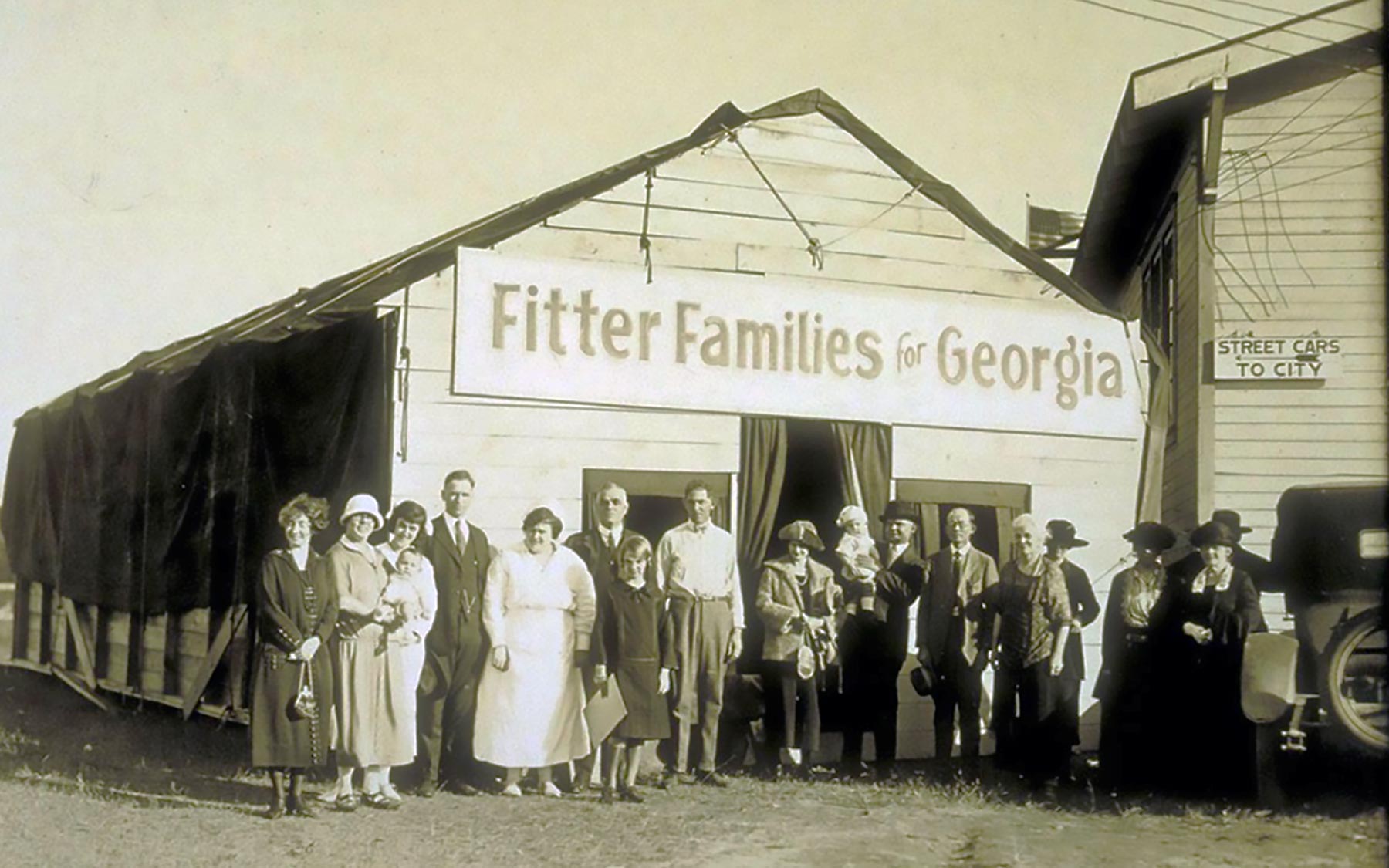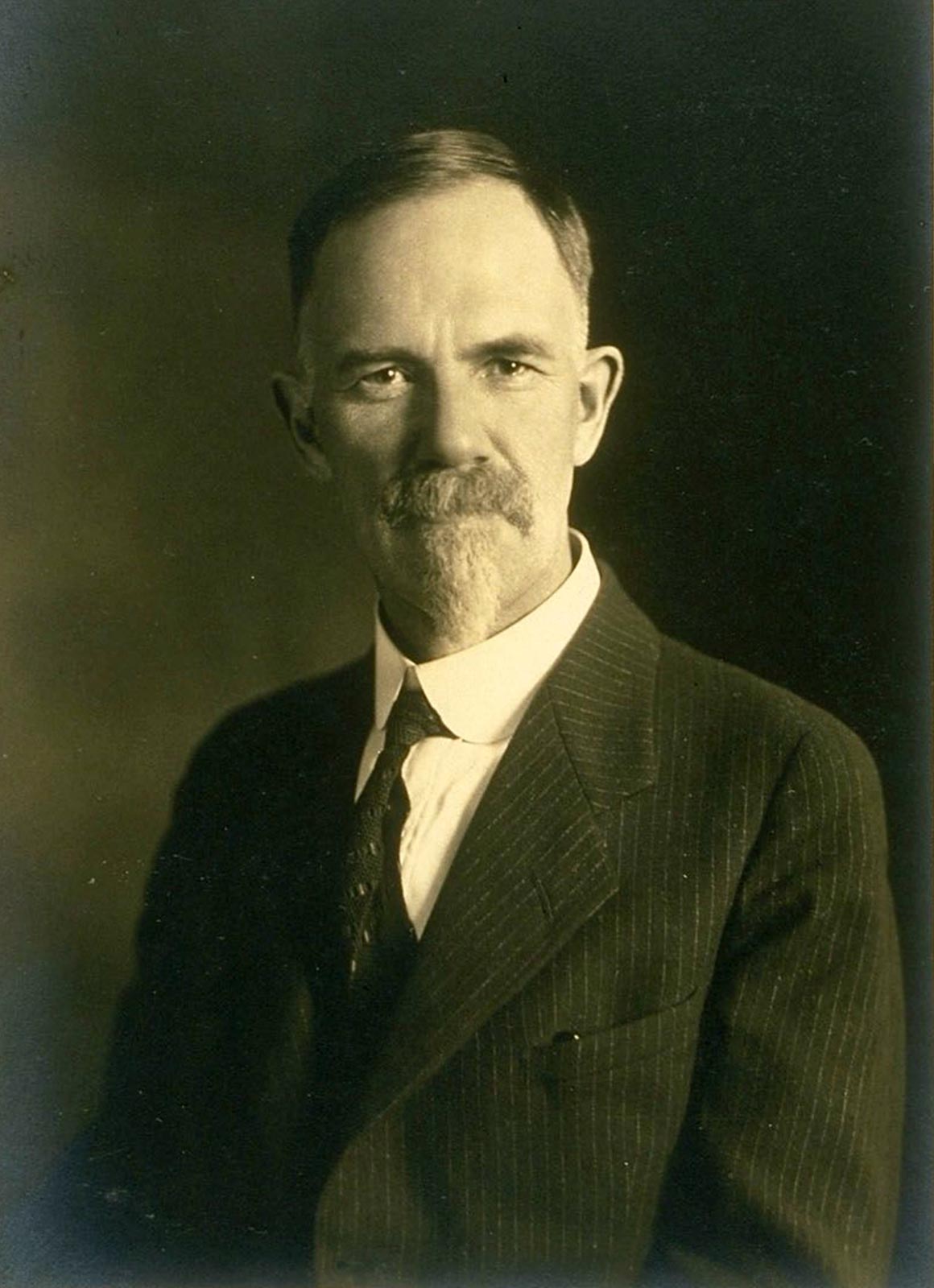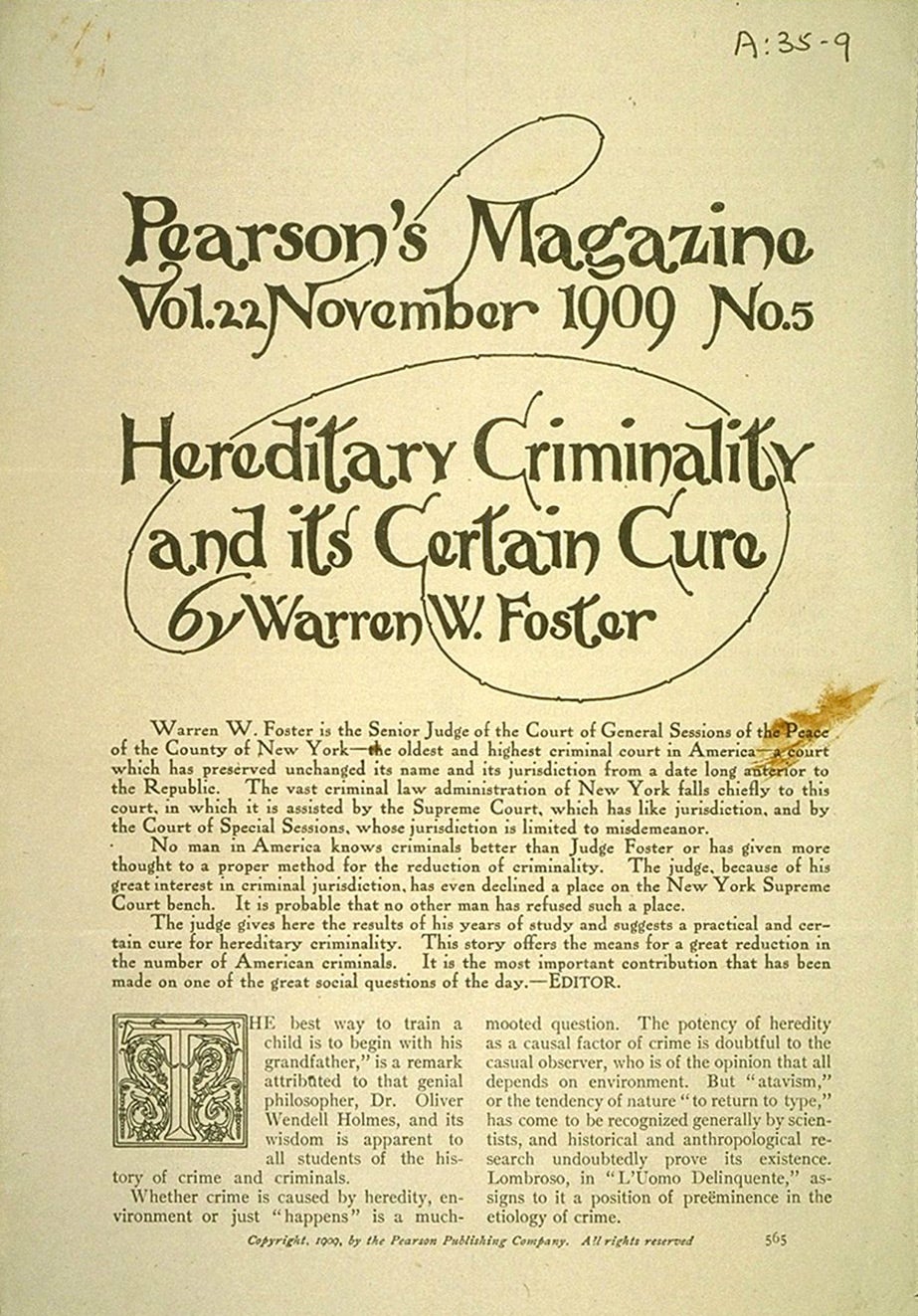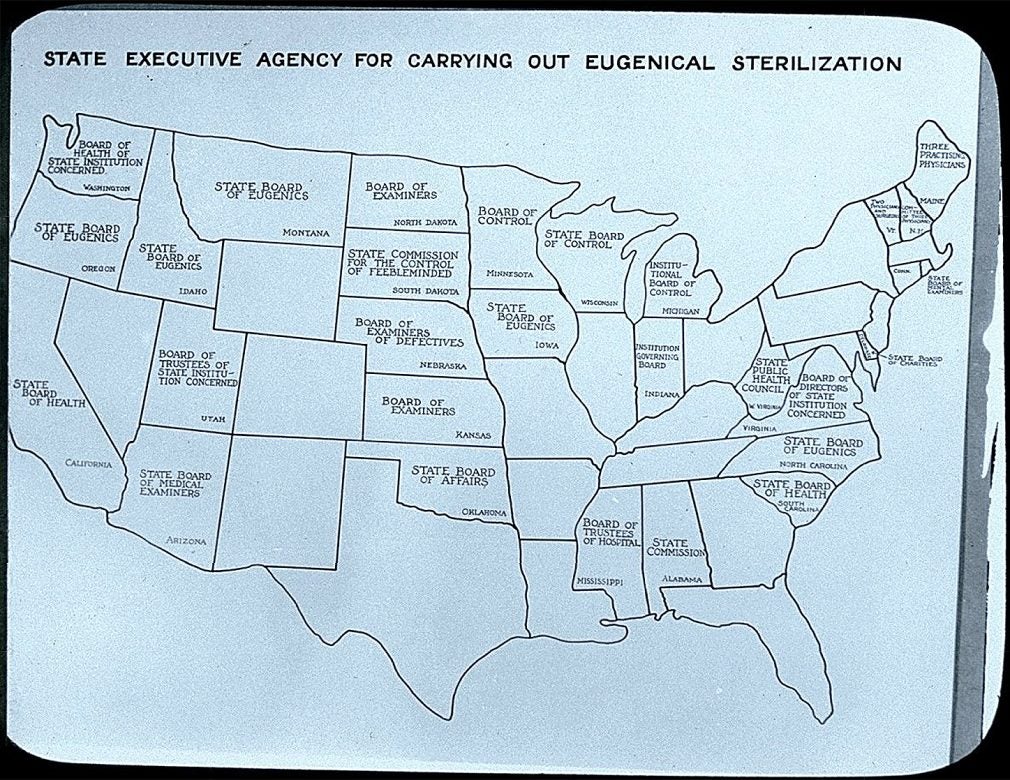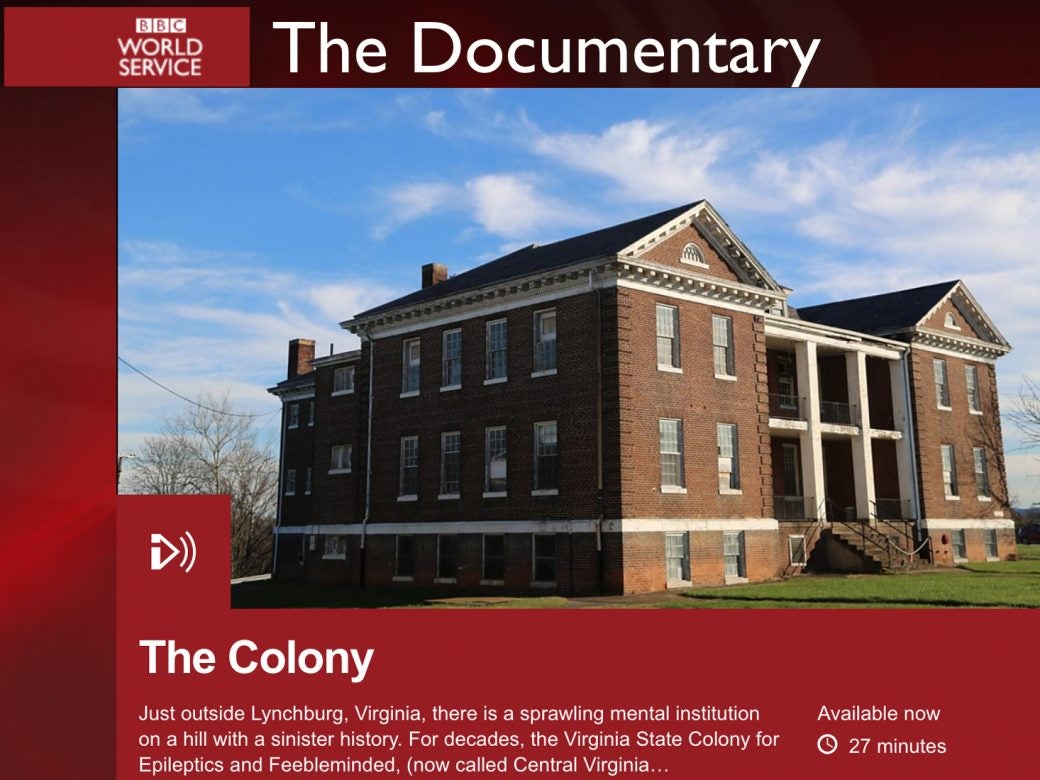Base Pairs podcast
The early 1900s was an exciting time to study genetics. Gregor Mendel’s famous laws of genetics had just been rediscovered at the turn of the century, giving rise to a field rich with untold truths about the nature of life. Yet it was during this period that the bogus concept of hereditary criminality and a made-up disease known as feeble-mindedness became part of some scientists’ so-called studies of genetics. Ideas such as these were at the core of the American eugenics movement, in which science got mixed up with racial dogma. Among the results was the destruction of thousands of people’s ability to pass on their “defective” genes through forced sterilization surgeries, a practice that swept across the United States (see map below).
Right now is also an exciting time to study genetics, and the invention of a powerful genome-editing tool known as CRISPR has much to do with this burst of enthusiasm. But as CRISPR offers the ability to make precise changes to the human genome, it also raises new concerns about controlling how genes get passed on—or don’t.
In this episode of Base Pairs, David Micklos, executive director of CSHL’s DNA Learning Center and leader of the effort to create an extensive online Eugenics Archive, and Miriam Rich, a doctoral student at Harvard studying the social and cultural history of science and medicine, help us figure out where genetic science went off the rails in the name of eugenics. Later in the episode, Jennifer Doudna, a professor at UC Berkeley and co-discoverer of the CRISPR, weighs in on how to responsibly use the new powers over the human genome that she helped bring into the world.
AA: With me, Andrea Alfano.
BS: What are we talking about today, Andrea?
AA: Good genes. And why science can’t tell us what they are.
BS: Science has helped us learn a lot about genes, though.
AA: That is something science can do. With tools like CRISPR (spell out) gene editing, scientists are able to gather this knowledge even more quickly.
BS: We talked about gene editing in plants a few episodes back, in “CRISPR vs. Climate Change.” CRISPR is a new tool that allows scientists to make precise changes to DNA. A plant scientist here used it to find genes in tomatoes that can be mutated to give them the ability to grow in new regions, which would come in handy if climate change causes their geographical range to shift.
AA: Just a little over a month after we released that episode, in August, the New York Times published a story with the headline, “In Breakthrough, Scientists Edit a Dangerous Mutation from Genes in Human Embryo.”
BS: I remember that story. Scientists claimed that they were able to use CRISPR to edit out a mutation from the human genome that causes a heart condition that can trigger sudden death later in life. Most people would probably not consider that to be a good gene.
AA: But importantly, like you said, the judgement of good versus bad comes from people—in other words, society—but not the science itself.
BS: Of course! How could it not? Science is a process—the scientific method of hypothesize, experiment, analyze, and repeat. When done properly, it gives us reproducible results and valuable knowledge that can help us make more informed decisions. But people still have to make decisions about how to use the knowledge that scientific experiments generate.
AA: That New York Times article about human gene editing has one line that really jumped out at me, because it gets at the big question of how to use scientific knowledge. It reads: “Some experts have warned that unregulated genetic engineering may lead to a new form of eugenics, in which people with means to pay have children with enhanced traits even as those with disabilities are devalued.”
BS: Eugenics was an idea in which issues of science and society got mixed up in horrific ways. I can see why the author mentioned that history as a warning.
AA: Until relatively recently, I honestly had no idea that there was a eugenics movement in the United States early in the 1900s, much less that as a result of this movement, the government forced thousands of people to undergo surgery that destroyed their ability to have children. I was hardly even familiar with the word eugenics, and I had only heard it used in the context of Nazi Germany when I did come across it.
DM: It was just taboo, nobody mentioned it.
AA: That’s David Micklos, executive director of CSHL’s DNA Learning Center, whose science education programs are aimed at preparing students in grades 5 through 12 for life in the genome age. It’s largely thanks to Dave that I now do know that there was a very prominent eugenics movement in the U.S. His effort to inform as many people as possible about this dark but important history started in 1995, earlier in his career at Cold Spring Harbor Laboratory.
DM: Well, I was poking around the archives a long time ago, and I pulled up a couple of tracks and brochures from the eugenics time — I was writing a little history of the Lab for the 100th anniversary, and so I put one paragraph on eugenics in it, and I think I said it was misguided at the very least, but it was pretty pabulum. But, that was the first word in a published synopsis of the Lab that eugenics had been mentioned since the Second World War.
BS: Those archives are here because the institution now known as CSHL was once a division of the Carnegie Institution of Washington. It was also home to the Eugenics Record Office. Dave Micklos was the leader of an effort to make those archives available online in the 1990s, which was still the early days of the web. You can check them out yourself at eugenicsarchive.org. CSHL has always considered this part of its history a really important “teachable moment” for people in the present day.
AA: The Eugenics Records Office was part of the Department of Genetics here during the early 1900s.
BS: The word eugenics is derived from the Greek “eu,” meaning “good,” and “genos,” which gave rise to the English word “gene,” right?
AA: Yes. But eugenics as it was employed in the early 1900s most closely translated to “good breeding”—which hints at how this “misguided at the very least” movement got its start through science. That’s a big part of what I wanted to find out from Dave: how did something that started out as a legitimate pursuit of scientific knowledge about genetics turn into a scientifically bankrupt, yet popular social movement?
DM: If you look at the people who were in the early American eugenics movement, a large number of them had come from backgrounds in plant and animal breeding. They thought they had some pretty good ideas about how things worked when you bred two parents and got an offspring, say corn plants, or pigs, or cattle, or horses. They thought they knew some of the principles behind how those genetic components from the parents came out in an offspring. So, if we had these ideas about how we could make a better pig or a faster racehorse or a bigger corn plant, why not use those principles in making human beings better?
BS: I could see the appeal of that idea. Studies in those other organisms did reveal evidence that inbreeding increases the risk of many genetic diseases, for example. In those days, it still wasn’t terribly uncommon to marry your cousin.
AA: That was actually one of the (quote) “chief activities” (unquote) of the Eugenics Record Office, according to a 1918 report from its director, Dr. Charles Davenport: “to advise concerning the eugenical fitness of proposed marriages,” particularly, “contemplated cousin matings.”
BS: People in Iceland are doing a high-tech version of that right now through a dating app called Bump that uses genealogical data to warn potential couples about incest. Since the population is so small in Iceland and last names aren’t that revealing of family history there, the chance of accidentally dating your cousin is actually pretty significant.
AA: Yeah, that’s one of Davenport’s ideas that’s still makes sense to a lot people today. In fact, despite having been a leader of the American eugenics movement, Davenport was a trained geneticist and, before coming to CSHL, a professor at Harvard.
DM: He also had some insight, more than a lot of people, that when genes went wrong, they could lead to certain kinds of diseases. For example, Davenport — worked out the classic formula that basically brown eyes are dominant over blue eyes, that genetic bit that everyone learns in high school.
BS: Wait, he was the one who figured out that brown eyes are dominant over blue eyes?!
AA: He was! So, he did start out doing legitimate, solid science, like that eye color paper from 1907. But let’s check in again ten years later, in 1917. Davenport listed a few of the (quote) “principal advances” (unquote) of the Department of Experimental Evolution at Cold Spring Harbor, which he also directed and which spawned the Eugenics Record Office. Let me know when you hear something suspicious:
The analysis of a new method of selecting the best egg-laying poultry.
The production of a “pure” highly abnormal race of beans.
The analysis of the juvenile traits and hereditary characteristics of successful naval men.
BS: Naval men? As in, men who are in the navy?
AA: That’s right.
DM: Davenport even published a study of sailors and of great naval captains and so forth, and thought that they had inherited a couple of genes basically in a linked fashion. And one of them, was called thalassophilia, love of the sea. Another one of them was fearlessness. Well, do you get the love of the sea cause it’s in a gene you inherit or is it because your father liked boats and your grandfather liked boats and you had one in the background and you lived next to the sea? But the eugenicists said, “Well, looks like it’s genetic.”
BS: Looking back, it’s easy to recognize that that’s just not science. There’s no scientific reason to think that family members’ shared love of the sea must have a genetic basis. Mistaking correlation for causation is such a basic error.
AA: Exactly. That’s a relatively harmless example of the non-science of eugenics. Unfortunately, not all of them are so humorous.
DM: A perfect example is the eugenicists and a lot of intelligent people around the world and in the US were really worried about one disease in the early 1900s, and it was called feeble-mindedness. Well, you haven’t ever heard of that disease because it doesn’t exist as a disease.
BS: What did they think feeble-mindedness was?
AA: Here’s how a doctor defined feeble-mindedness in 1912 in the prestigious New England Journal of Medicine: it is “the synonym of human inefficiency and one of the great sources of human wretchedness and degradation.”
BS: That definition isn’t scientific, it’s just mean!
AA: It is mean. And when that kind of unscientific approach gets applied to social issues, it becomes even more problematic. Davenport wrote in 1911 that, “anyone acquainted with rural poorhouses, particularly in the South, will appreciate that the people housed in them are mostly mentally inferior.” He also became involved in issues of immigration to the U.S., and specifically, curtailing immigrants’ introduction of what he described as “defective alien germplasm.”
BS: And feeble-mindedness was one of those “defects”?
AA: To eugenicists, yeah. By attributing supposedly scientific causes, like feeble-mindedness, to social phenomena, like poverty, people like Davenport lent scientific legitimacy to eugenic ideas—even though there wasn’t any. And already-marginalized people, like immigrants and the poor, were harmed as a result.
BS: I think I see where this is going. If Davenport thought that love of the sea was genetic, he surely thought that feeble-mindedness was, too.
AA: He did. And he wasn’t the only one. Many people were convinced that this unscientifically-defined trait of feeble-mindedness had a genetic basis, and they took action to prevent these “defective” or “inadequate” genes, as they were called, from spreading through the population.
DM: So, you could segregate them, and hope that they didn’t get out and reproduce, or you could just sterilize them, which was a surer solution to what they thought was a eugenic problem. It was on the strength of this sort of fear of feeble-mindedness that the law that allowed eugenic sterilization passed the United States Supreme Court.
BS: I know about this. Dave’s talking about the infamous Buck vs. Bell case. Eugenicists decided that a young woman named Carrie Buck from Virginia was so feeble-minded that she should be sterilized—meaning that her ability to have children would be surgically destroyed—and in 1927, the U.S. Supreme Court agreed, 8 to 1.
AA: One of the things I found really striking about the American eugenics movement is that it was very mainstream. That Supreme Court decision really shows that eugenics was not some fringe movement.
BS: I remember from a post you wrote for our LabDish blog that in the early 1900s, a family might for example go to the state fair and enter a “fitter families” competition in which they were basically judged on how good their breeding appeared to be. There are photos of grinning parents, children, and grandparents being judged like livestock at these competitions and it’s… unsettling to say they least – but if you’re interested in checking them out, and I hope you are, you can find them at LabDish.cshl.edu.
AA: It really shows how widespread eugenic ideas were at this time, even among the general public. I was also amazed to see that on the Google Books Ngram viewer, which shows the prevalence of words in books over time, the word “eugenics” is actually far more prevalent than the word “genetics” from 1900 until around 1930.
BS: That make some sense, actually. These were the earliest days of genetics! Mendel’s famous laws, which gave rise to the field, only came to light around the turn of the 20th century. So, then what happened after 1930?
AA: There’s a decline in the usage of “eugenics,” as it became thoroughly discredited within the scientific community, while “genetics” steadily became more prevalent.
BS: And eugenics just disappeared? Usage of the word could still go up, even after most people have rejected what it stands for. It’s part of learning from history, just like what we’re doing now.
AA: Well, just before 1990, the use of the word “eugenics” really picks up again, for the kinds of reasons you’re getting at. Quiz time, Brian: As a CSHL employee (hint, hint) does that timing, around 1990, seem curious to you?
BS: Hmmm, the Human Genome Project started in 1990. That was the initiative to write out every DNA “letter” in the human genome, so it seems like it could be a good time to revisit the history of eugenics.
AA: Correct! CSHL’s director at the time, James Watson, was also a leader of the project. Here’s Dave Micklos again.
DM: When Watson became a first director of the Human Genome Project, he got it written into the operations of the genome project that 3% of the research budget should go to the consideration of ethical, legal, and social implications of genome research. Well, that had never been done before.
BS: I can’t believe that wasn’t already standard practice!
AA: Neither could I, but I’m glad they helped get that ball rolling. Dave got a grant from the National Institutes of Health, or NIH, to put materials from the Eugenics Record Office and other eugenics archives on a website.
DM: People said, “Yeah, there’s obviously lessons to be learned from our first involvement with human genetics and our current involvement with genomics.”
BS: So, Watson’s point was, how would we protect citizens’ genetic information—information that could be used to discriminate against them—in a future where the human genome could be “read”?
AA: Yes, and that’s the work that we still need to do today. How do we let people know what they’re in for as scientists gain the ability not only to “read” the human genome, but to edit it?
MR: It’s not, sort of, the kind of issue where there’s going to be a conversation that reaches closure and we’ve addressed all the ethical issues and there’s nothing more to talk about. There really needs to be a commitment to ongoing discussion around those issues.
AA: That’s Miriam Rich, a doctoral student at Harvard who’s studying the history of science, particularly the social and cultural history of medicine in the U.S. as it relates to gender and race.
BS: I learned about Miriam’s work because she’s researching the history of eugenics with support from the Sydney Brenner Research Scholarship from CSHL’s Library & Archives.
AA: I wanted to know what goes through her mind as she reads the latest CRISPR gene editing news.
MR: I think conversations around the value and uses of gene editing technology should really be careful to avoid this trap of expecting that a new genetic technology, as promising as it may be for, you know, for many applications, but not expect that it can serve as a catchall cure or replacement for addressing social, political, and environmental problems. I think that was really an issue with eugenics—that rigid commitment to not being able to imagine that there were problems that were better addressed through social and political and environmental change, as well as through thinking about genetics and heredity.
BS: That’s a great point. As much as we believe in the power of genetic information—it is what this podcast is about, after all—it’s not all-powerful.
AA: Davenport definitely fell into that trap. In 1913, in an article in the magazine Popular Science, he wrote: “The recognition of the part that heredity plays in determining human behavior … leads us to recognize the true worth and the real limitations of education, religion and other good influences, and leads us to conclude that the greatest advance that humanity can make is to secure an increasing proportion of fit marriages producing the largest number of effective, socially good offspring to carry on the world’s work.”
BS: So, how do we avoid this trap?
AA: Well, when Jennifer Doudna, a professor at UC Berkeley and co-discoverer of the CRISPR gene editing technology, was recently here at CSHL for a scientific meeting, she talked about how she looks to history for guidance. In contrast to the cautionary example of eugenics, she described an inspirational one.
JD: I think a great example of this is actually looking back to the 1970s when molecular—what we call molecular cloning—was getting started. And that just means being able to make copies of desired genes, typically by putting them into the DNA of bacteria. And the bacteria that scientists were using for those experiments were bacteria that can grow in the human gut. And so, people realized, gee, this could be a problem! (laughter) Potentially. So, that led to conversations that were convened in Asilomar, California by scientists who wanted to get a conversation going about the responsible use of molecular cloning. And that became known as the Asilomar Meeting and led to some initial restrictions on molecular cloning until it could be shown to be safe.
BS: This was really cool. About 15% of the participants at Asilomar were from the media, which helped keep the public well informed about the deliberations, including all of the initial indecisiveness and arguing as well as the consensus that eventually came out of them.
JD: We’re trying to take that same approach now with CRISPR technology, and really try to get people interested in learning about this, people who are not scientists. It’s one of the reasons it’s great you’re doing this podcast. But to have people understand the beauty and power of this technology and the kinds of things it’s enabling, but also to appreciate that it has real potential to be misused as well. And so, we need to be very actively discussing appropriate ways to proceed. So, we had a great talk the first night of this meeting (BS: the recent CSHL gene editing meeting, that is) by Richard Hynes from MIT, who has been—was the co-chair of a committee that reviewed the application of CRISPR technology in a particular setting, in what’s called the human germline. That means being able to make changes to DNA in human embryos or human eggs or sperm that we would heritable. So, they’d become transmitted to future generations. Very—something that cuts right to the core with eugenics, right?
BS: That’s for sure. Eugenics and genome editing of the germline are both issues of controlling reproduction. I know that Dr. Doudna herself has called for a worldwide moratorium on using CRISPR to make these heritable changes to the human genome, and many other scientists have joined her.
AA: Right now, in the United States, the use of federal funds for research for creating heritable modifications in human embryos is prohibited.
BS: But some of the research in that study we talked about at the beginning of this episode—the one where scientists edited out a mutation for a potentially deadly heart condition from a human embryo—some of that work was done in the US. Somehow, they got around the federal funding barrier.
AA: There are clearly mixed feelings about this kind of work even within the US, let alone around the world. Earlier this year, the National Academy of Sciences and the National Academy of Medicine got together to discuss the science, ethics, and regulation of human genome editing. Perhaps the most important line in their report is this: “Given both the technical and societal concerns, the committee concludes there is a need for caution in any move toward germline editing, but that caution does not mean prohibition.” Even though Dr. Doudna has called for at least temporary prohibition, she seems to agree with the Academies about the appeal of human germline editing.
JD: It has the power to possibly relieve families of mutations that might lead to cancer and to other very disabling diseases. And so, this is something that everyone now is grappling with. How do we proceed? There are no easy answers, but I think one thing that’s happening which is good is that there are a lot of people engaging in that discussion.
AA: Again, science alone can’t give us the answers here. It can’t tell us how we should and should not use technologies like CRISPR in our lives. But Miriam Rich did offer some insights into what needs to be considered and who needs to be included in those discussions.
MR: Whenever you’re dealing with a science of human reproduction or a question that’s about managing human reproduction, you know obviously, the science itself is pivotal but it’s never going to just be about science. — It’s really important to have input and voices of many different people and communities, particularly those who may be most vulnerable to potential harm and certainly the historical example of eugenics demonstrates how communities most vulnerable to harm are, again, those who are already marginalized in society.
AA: The report from the National Academies echoes this sentiment, urging that “public education and engagement are crucial in the process of assessing and applying societal values to the risks and benefits of genome editing technologies.”
BS: Absolutely. That’s why we put this episode together. Where do you draw the line between ethical and unethical uses of human genome editing? Deadly diseases? Disabling diseases? What about enhancing human traits? Hopefully you listeners out there will help, too, by talking to the people in your daily life about these issues. It may seem small, but these little conversations can add up to make a big difference.
AA: I hope so too. Science shows what is possible to do. It’s up to all of us, scientists and non-scientists of all backgrounds, to use that knowledge to figure out what is right to do in our very nuanced society.
Extras for Episode 12
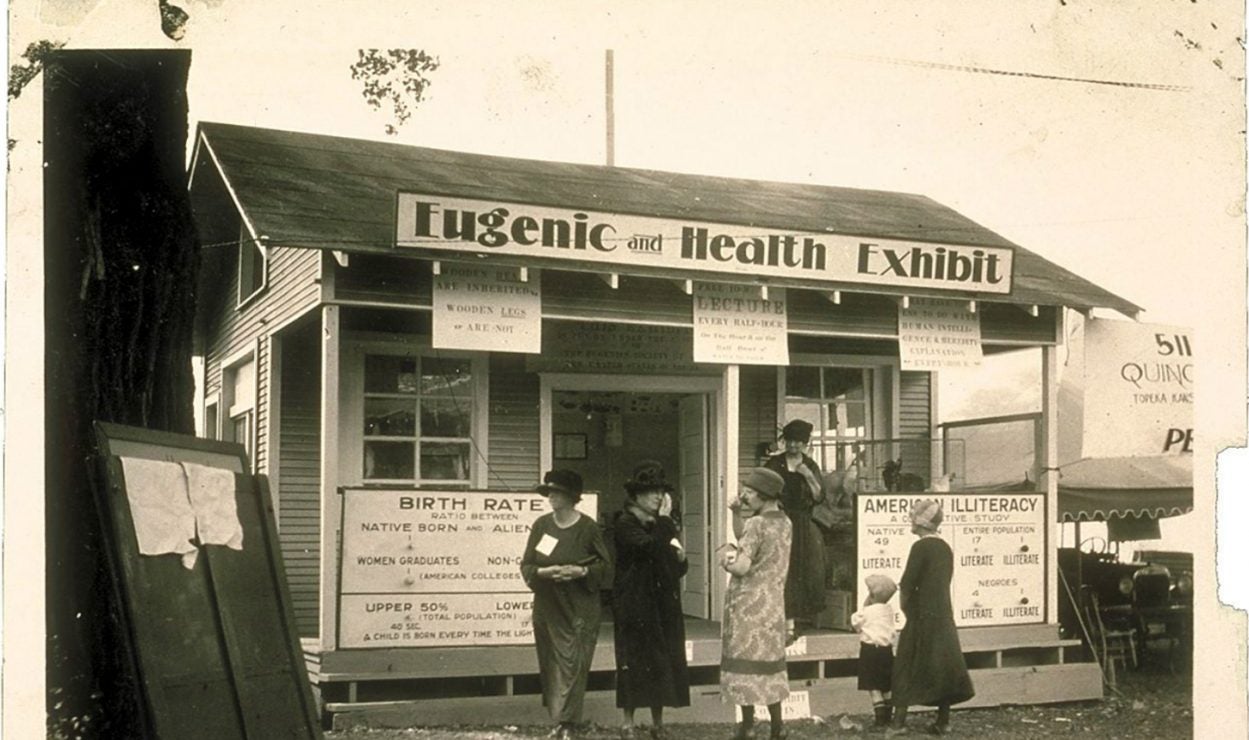
How has the world of biology and genetics learned from the American eugenics movement? What can we take from these lessons as we move toward a future of increasing technological capability with respect to human genes and traits? Author, geneticist, and former president of the American Society of Law, Medicine and Ethics, Philip R. Reilly, M.D., J.D., explored this fascinating subject recently at a CSHL public lecture. View the lecture below:
NBC’s Left Field interviewed David Micklos, executive director of CSHL’s DNA Learning Center, for their video (below) “White Supremacy, Eugenics and the History of Selective Breeding.”
A 1929 portrait of Charles B. Davenport, a leader of the American eugenics movement and at the time former director of the Department of Genetics of the Carnegie Institution of Washington, one of the predecessors of the modern Cold Spring Harbor Laboratory. The Eugenics Record Office was founded during Davenport’s tenure, but was shut down by Carnegie in the late 1930s.
An article titled Heredity Criminality and its Certain Cure, by Warren Foster in a 1909 issue of Pearsons Magazine. Eugenicists claimed that criminal behavior was a result of defective genes. (Credit: American Philosophical Society. Noncommercial, educational use only.)
“State executive agency for carrying out eugenical sterilization,” circa 1935. (Credit: The Harry H. Laughlin Papers, Truman State University)
The Documentary, a podcast from the BBC World Service, visited CSHL for an episode about eugenics and its long-lasting legacy in the United States. Listen to the The Colony episode.
Written by: Andrea Alfano, Content Developer/Communicator | webservices@cshl.edu | 516-367-8455
